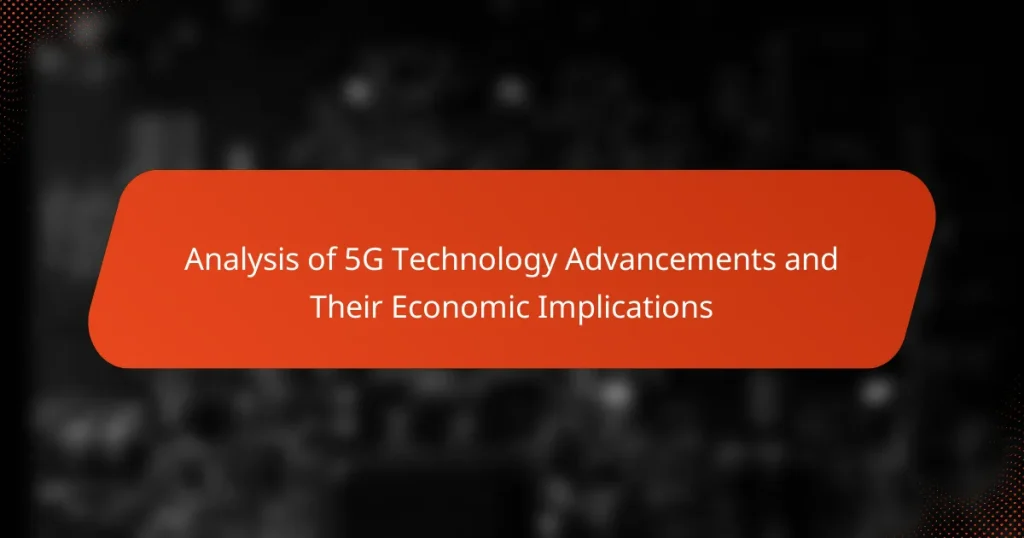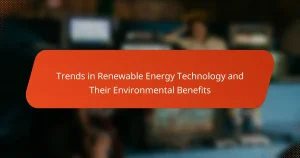5G technology represents a significant advancement in telecommunications, characterized by enhanced data speeds, reduced latency, and improved connectivity. With capabilities of delivering data speeds up to 20 Gbps and latency as low as 1 millisecond, 5G supports a greater number of devices, facilitating the growth of the Internet of Things (IoT). The economic impact of 5G is projected to reach $13.2 trillion by 2035, driving innovation and job creation across sectors such as healthcare, transportation, and smart cities. Additionally, the implementation of network slicing, massive MIMO technology, and beamforming enhances the efficiency and quality of connectivity, enabling transformative applications that will shape the future of various industries.
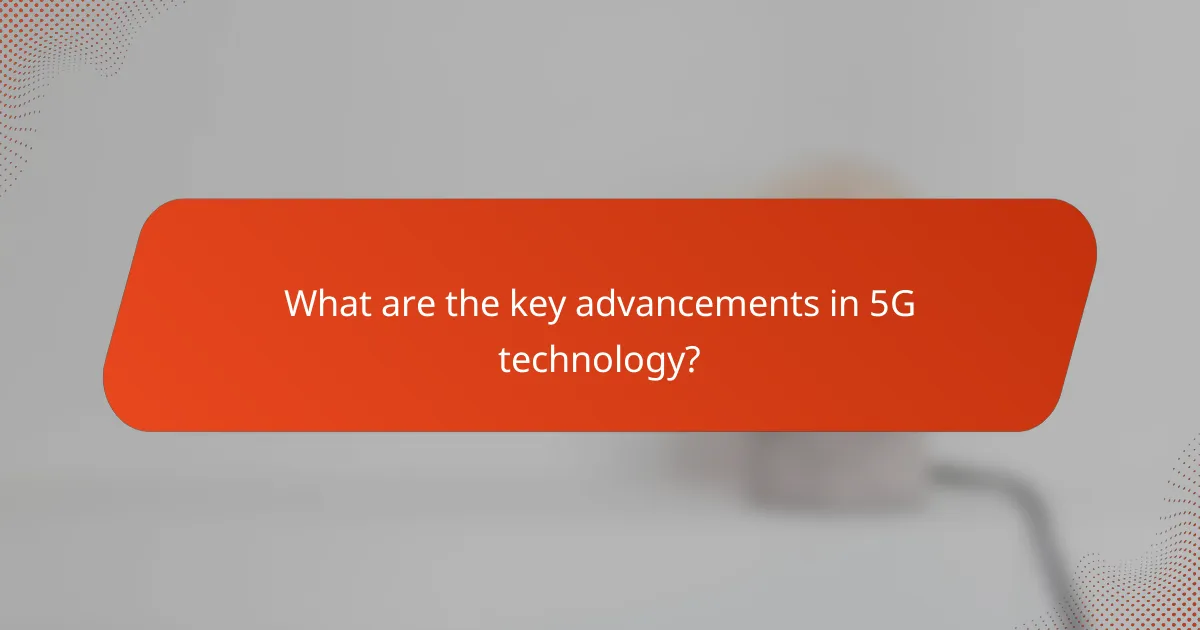
What are the key advancements in 5G technology?
Key advancements in 5G technology include enhanced data speeds, reduced latency, and increased connectivity. 5G networks can deliver data speeds up to 20 Gbps, significantly faster than 4G. Latency in 5G can be as low as 1 millisecond, enabling real-time communication. The technology supports a larger number of devices per square kilometer, accommodating the Internet of Things (IoT). Network slicing allows for customized connectivity solutions tailored to specific applications. Massive MIMO technology improves capacity and efficiency by using multiple antennas. Beamforming enhances signal quality by directing signals to specific users. These advancements collectively enable innovative applications in various sectors, including healthcare, transportation, and smart cities.
How does 5G technology differ from its predecessors?
5G technology differs from its predecessors primarily in speed, capacity, and latency. 5G offers download speeds up to 10 Gbps, significantly higher than 4G’s maximum of 1 Gbps. The capacity of 5G networks allows for a larger number of connected devices, supporting up to 1 million devices per square kilometer compared to 4G’s 100,000. Latency in 5G is reduced to as low as 1 millisecond, while 4G typically has latency around 30-50 milliseconds. This reduction in latency enables real-time applications like remote surgery and autonomous vehicles. Furthermore, 5G utilizes advanced technologies like millimeter waves and Massive MIMO, enhancing overall performance. These advancements position 5G as a transformative technology for various industries, enabling innovative applications and economic growth.
What technical specifications define 5G technology?
5G technology is defined by several key technical specifications. These include a peak data rate of up to 20 Gbps. The latency is reduced to as low as 1 millisecond. 5G operates on a frequency range that extends from below 1 GHz to 100 GHz. It supports massive machine-type communications with a connection density of up to 1 million devices per square kilometer. The technology utilizes advanced antenna technologies, such as Massive MIMO (Multiple Input Multiple Output). 5G networks can achieve bandwidths of up to 400 MHz in the sub-6 GHz range. The technology also supports network slicing, allowing for multiple virtual networks on a single physical infrastructure. These specifications collectively enhance the performance and capability of mobile networks, enabling new applications and services.
What innovations have been introduced with 5G networks?
5G networks have introduced several key innovations. Enhanced data speeds are among the most significant, reaching up to 10 Gbps. This allows for faster downloads and improved streaming capabilities. Lower latency is another critical advancement, with response times as low as 1 millisecond. This is crucial for applications requiring real-time communication, such as autonomous vehicles. Increased connectivity supports a larger number of devices simultaneously, facilitating the Internet of Things (IoT). Network slicing enables customized network experiences for different use cases, optimizing performance. Furthermore, 5G incorporates advanced technologies like Massive MIMO and beamforming, enhancing signal quality and coverage. These innovations collectively transform industries and boost economic growth.
What are the potential applications of 5G technology?
5G technology has several potential applications that significantly enhance connectivity and efficiency. One major application is in smart cities, where 5G enables real-time data collection and management. This technology supports autonomous vehicles by providing low-latency communication for navigation and safety. Additionally, 5G enhances telemedicine, allowing for remote surgeries and consultations with high-definition video. The technology also boosts augmented reality (AR) and virtual reality (VR) experiences by delivering high-speed data transfer. In manufacturing, 5G facilitates the Internet of Things (IoT), connecting devices for improved automation and monitoring. Furthermore, 5G can transform agriculture through precision farming, optimizing resource use and crop yields. These applications demonstrate the transformative potential of 5G across various sectors, highlighting its role in driving economic growth and innovation.
How can 5G enhance mobile communication experiences?
5G can enhance mobile communication experiences by providing significantly faster data speeds. This technology offers peak download speeds of up to 10 Gbps. Such speeds enable seamless streaming of high-definition content. Additionally, 5G reduces latency to as low as 1 millisecond. This improvement allows for real-time interactions in applications like gaming and virtual reality. Furthermore, 5G supports a higher density of connected devices. This capability is crucial for smart cities and the Internet of Things (IoT). Overall, these advancements lead to improved user satisfaction and more efficient communication.
What role does 5G play in the Internet of Things (IoT)?
5G plays a crucial role in the Internet of Things (IoT) by providing faster data transfer speeds and lower latency. This technology enables real-time communication between devices, enhancing their responsiveness. With 5G, IoT devices can connect more efficiently, supporting a larger number of devices simultaneously. The increased bandwidth allows for the transmission of high-definition data, essential for applications like smart cities and autonomous vehicles. Additionally, 5G’s ability to reduce latency to as low as 1 millisecond improves the performance of time-sensitive applications. Research from the GSMA predicts that 5G will connect over 1.5 billion IoT devices by 2025, showcasing its significant impact on the IoT landscape.
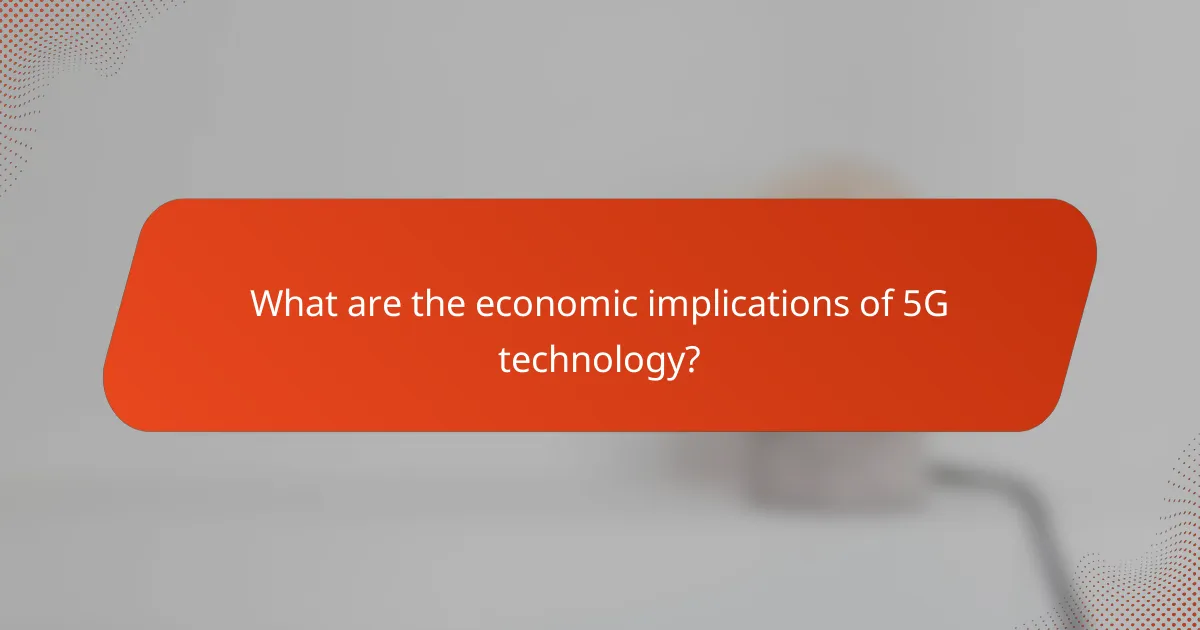
What are the economic implications of 5G technology?
5G technology has significant economic implications. It is expected to contribute $13.2 trillion to the global economy by 2035. This growth stems from enhanced connectivity and increased efficiency across various industries. Sectors such as healthcare, transportation, and manufacturing will benefit from faster data transfer and improved automation. The technology will also create new job opportunities, particularly in tech-related fields. Additionally, 5G will facilitate the development of smart cities, leading to improved public services and infrastructure. Investment in 5G infrastructure is projected to exceed $1 trillion globally. This investment will stimulate economic growth and innovation.
How can 5G technology impact economic growth?
5G technology can significantly impact economic growth by enabling faster data transmission and enhancing connectivity. This increased speed supports the growth of industries such as healthcare, manufacturing, and transportation. For instance, 5G facilitates the use of telemedicine, allowing remote consultations and improving healthcare access. In manufacturing, it enables real-time monitoring and automation, boosting productivity and efficiency. According to a report by the consultancy firm IHS Markit, global 5G adoption could contribute $13.2 trillion to the global economy by 2035. This growth stems from improved business operations and the creation of new markets. Additionally, 5G can enhance mobile broadband services, increasing consumer spending. Overall, 5G technology is poised to reshape various sectors and drive substantial economic growth.
What industries are likely to benefit economically from 5G?
Telecommunications, healthcare, automotive, manufacturing, and entertainment industries are likely to benefit economically from 5G. Telecommunications will see enhanced network capacity and speed, enabling better connectivity. Healthcare can utilize 5G for telemedicine and remote surgeries, improving patient care. The automotive industry will benefit from advancements in connected vehicles and autonomous driving technologies. Manufacturing will leverage 5G for automation and smart factories, increasing efficiency. The entertainment industry will experience improved streaming services and augmented reality applications. These benefits can lead to increased revenue and innovation across these sectors.
How does 5G technology influence job creation and employment?
5G technology significantly influences job creation and employment by enabling new industries and enhancing existing ones. It facilitates advancements in sectors like telecommunications, healthcare, and transportation. The introduction of 5G networks is projected to create 3 million new jobs in the United States by 2025, according to a report by the Economic Policy Institute. This technology allows for increased automation and efficiency, leading to higher productivity in businesses. Enhanced connectivity supports remote work and creates opportunities for gig and freelance jobs. Additionally, 5G’s impact on IoT (Internet of Things) fosters job growth in software development and data analysis. Overall, 5G technology acts as a catalyst for economic growth and employment expansion.
What are the challenges associated with 5G technology implementation?
The challenges associated with 5G technology implementation include high infrastructure costs and regulatory hurdles. Building the necessary infrastructure requires significant investment in new equipment and technology. This can lead to financial strain on telecommunications companies. Additionally, regulatory approvals can delay deployment. Local governments may impose strict regulations on tower placements and environmental assessments. There are also technical challenges like signal attenuation and the need for dense networks. 5G operates at higher frequencies, which have limited range and [censured]. This necessitates more base stations to ensure coverage. Furthermore, cybersecurity concerns arise due to increased connectivity. More devices connected to the network can lead to vulnerabilities. Lastly, there is a need for skilled workforce to manage and maintain 5G networks. The lack of trained professionals can slow down the implementation process.
What regulatory hurdles must be overcome for 5G deployment?
5G deployment must overcome several regulatory hurdles. These include obtaining spectrum licenses, which are essential for operating the network. The Federal Communications Commission (FCC) in the United States plays a crucial role in this process. Local zoning laws can also impede the installation of necessary infrastructure, such as cell towers. Compliance with safety regulations regarding electromagnetic exposure is another requirement. Environmental assessments may be mandated before construction can begin. Coordination with various governmental and municipal agencies is often necessary, adding complexity to the deployment timeline. Additionally, public opposition to new infrastructure can create significant delays. Each of these hurdles must be addressed to facilitate successful 5G rollout.
How does infrastructure investment affect the economic landscape of 5G?
Infrastructure investment significantly enhances the economic landscape of 5G. Increased funding leads to improved network capabilities and coverage. This investment supports the deployment of essential infrastructure like fiber optics and small cell technology. Enhanced infrastructure results in faster data speeds and lower latency. According to a report by the Brookings Institution, 5G deployment could contribute $500 billion to the U.S. economy by 2025. Additionally, better connectivity fosters innovation across various sectors. Industries such as healthcare, transportation, and manufacturing benefit from advanced 5G applications. Overall, infrastructure investment is crucial for realizing the full economic potential of 5G technology.
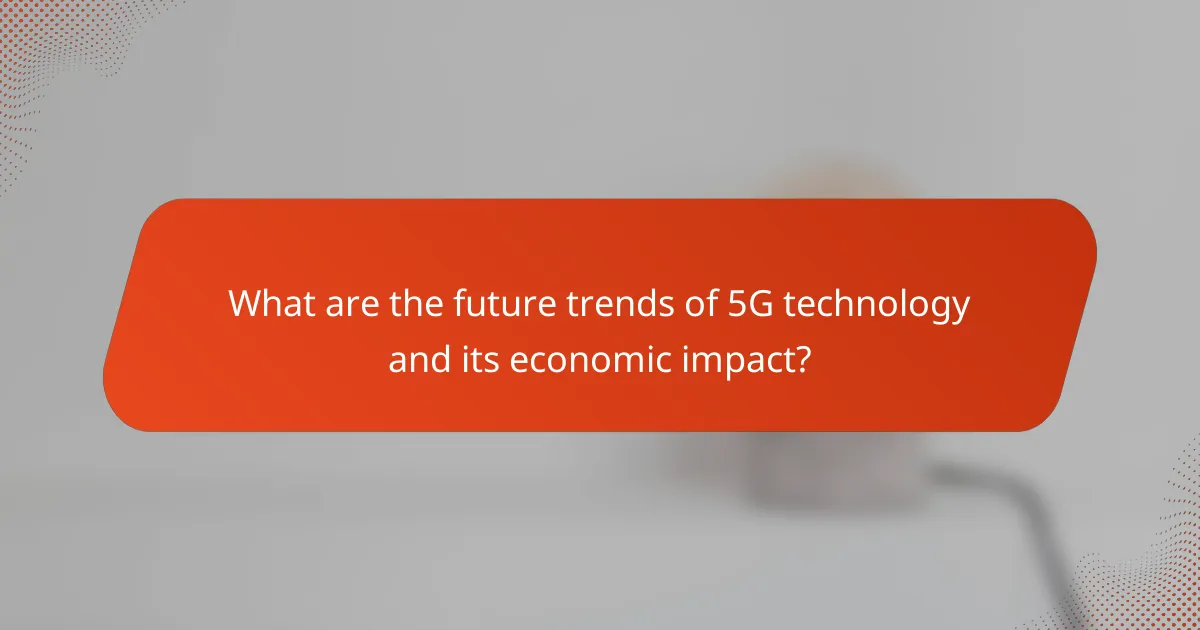
What are the future trends of 5G technology and its economic impact?
The future trends of 5G technology include enhanced connectivity, increased data speeds, and widespread adoption across industries. 5G will enable the Internet of Things (IoT) to flourish, connecting billions of devices seamlessly. This technology will support advancements in smart cities, autonomous vehicles, and telemedicine. The economic impact of 5G is projected to be significant, with estimates suggesting it could add $13.2 trillion to the global economy by 2035. Additionally, 5G will create millions of jobs in sectors such as technology, manufacturing, and services. As businesses leverage 5G capabilities, productivity and efficiency are expected to improve. The rollout of 5G infrastructure will also drive investment in related technologies and services.
How will 5G technology evolve in the coming years?
5G technology will evolve through increased speed, reduced latency, and expanded coverage. The deployment of 5G networks will enhance mobile broadband experiences. Emerging applications will include smart cities, autonomous vehicles, and enhanced IoT connectivity. According to the GSMA, global 5G connections are expected to reach 1.4 billion by 2025. Enhanced network slicing will allow tailored connectivity for different industries. Additionally, advancements in edge computing will support real-time data processing. The integration of artificial intelligence will optimize network management and efficiency. As of 2023, 5G technology is anticipated to drive significant economic growth and innovation across various sectors.
What emerging technologies will be influenced by 5G advancements?
5G advancements will significantly influence several emerging technologies. These include the Internet of Things (IoT), which will benefit from faster data transmission and improved connectivity. Smart cities will evolve with enhanced infrastructure thanks to 5G, enabling real-time data collection and analysis. Autonomous vehicles will rely on 5G for low-latency communication, improving safety and efficiency. Augmented reality (AR) and virtual reality (VR) applications will become more immersive with the increased bandwidth of 5G. Remote healthcare technologies will advance, allowing for real-time patient monitoring and telemedicine services. Additionally, industrial automation and smart manufacturing will leverage 5G for better connectivity between machines and systems. The gaming industry will also experience enhancements in cloud gaming capabilities, thanks to 5G’s high-speed internet. Overall, 5G will act as a catalyst for innovation across these technologies.
What best practices should businesses adopt to leverage 5G technology?
Businesses should adopt several best practices to leverage 5G technology effectively. First, they should invest in infrastructure upgrades to support 5G connectivity. This includes enhancing network capabilities and ensuring compatibility with existing systems. Second, businesses must prioritize cybersecurity measures. 5G networks introduce new vulnerabilities that require robust security protocols. Third, they should explore innovative applications of 5G. Use cases include IoT integration, real-time data analytics, and enhanced customer experiences. Fourth, businesses should train employees on 5G technology. Understanding its potential can drive better implementation and utilization. Finally, collaboration with technology partners is essential. Strategic alliances can facilitate access to expertise and resources. These practices are supported by a report from the GSMA, which highlights that 5G can boost global GDP by $2.2 trillion by 2030 through enhanced productivity and innovation.
How can companies prepare for the integration of 5G into their operations?
Companies can prepare for the integration of 5G by assessing their current infrastructure. They should evaluate network capabilities to support higher speeds and lower latency. Upgrading hardware and software systems is essential for compatibility with 5G technology. Training employees on 5G applications will enhance operational efficiency. Collaborating with telecom providers can facilitate a smoother transition. Developing a strategic plan that outlines specific use cases for 5G will guide implementation. According to a report by Ericsson, businesses adopting 5G can expect significant productivity gains, underscoring the importance of preparation.
The main entity of the article is 5G technology, which represents a significant advancement in mobile communication. The article provides a comprehensive analysis of key advancements in 5G, including enhanced data speeds, reduced latency, and increased connectivity, alongside its technical specifications and innovations. It explores the economic implications of 5G, highlighting potential applications across various sectors such as healthcare, transportation, and smart cities, and discusses the expected economic growth and job creation resulting from its implementation. Additionally, the article addresses challenges related to infrastructure investment and regulatory hurdles that must be overcome to fully realize the benefits of 5G technology.
